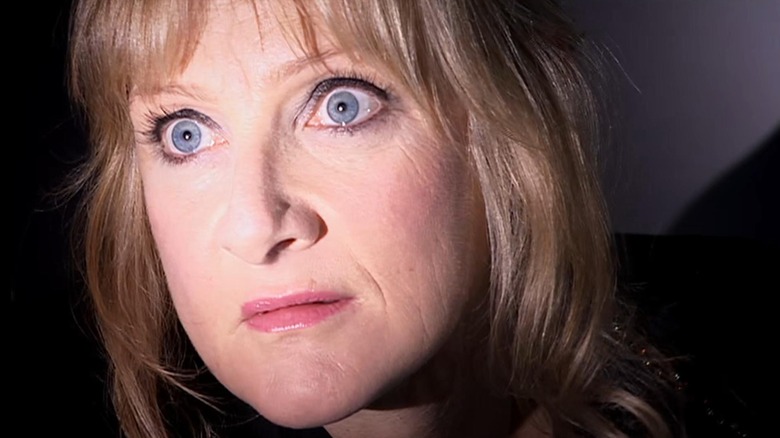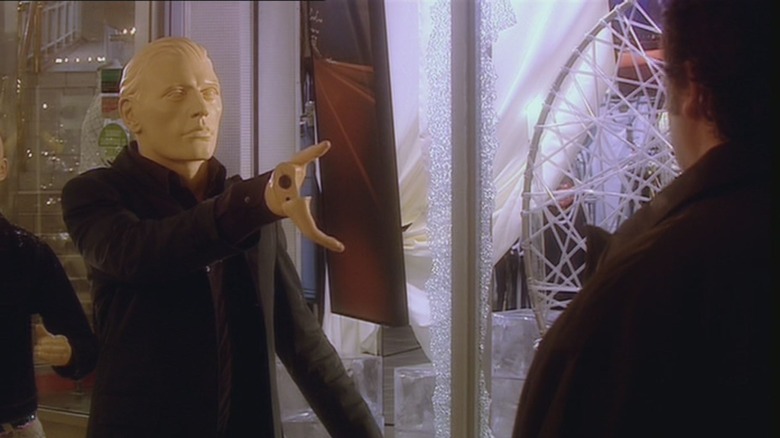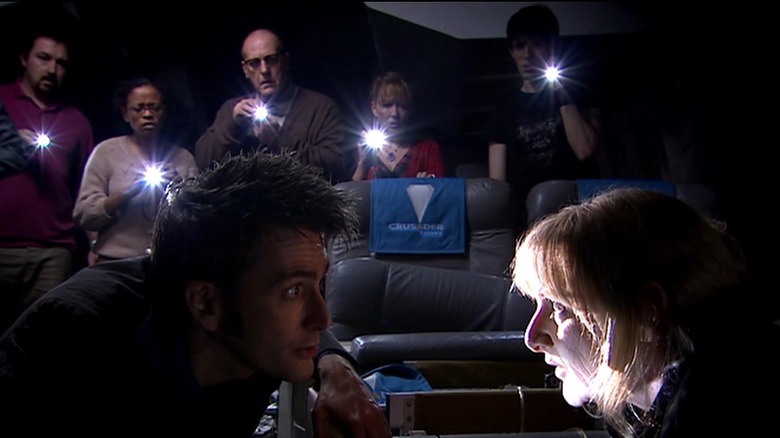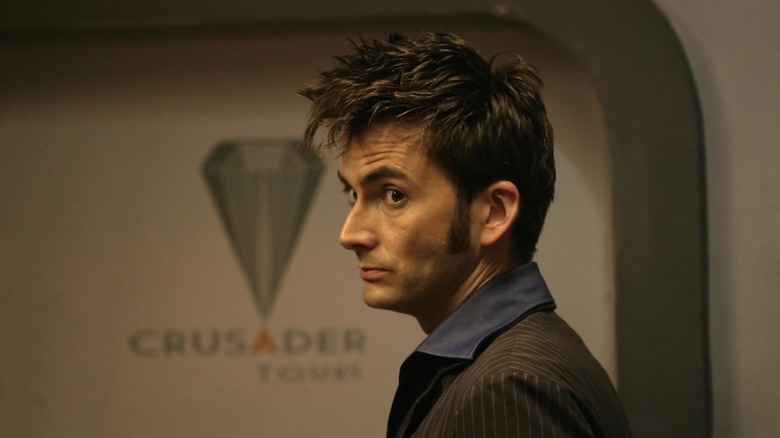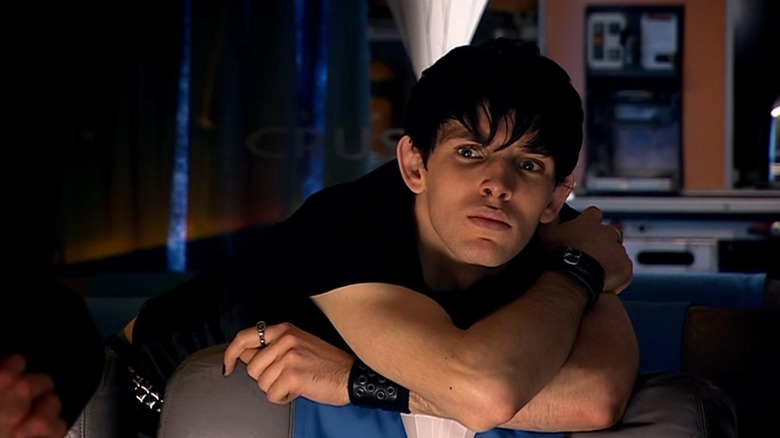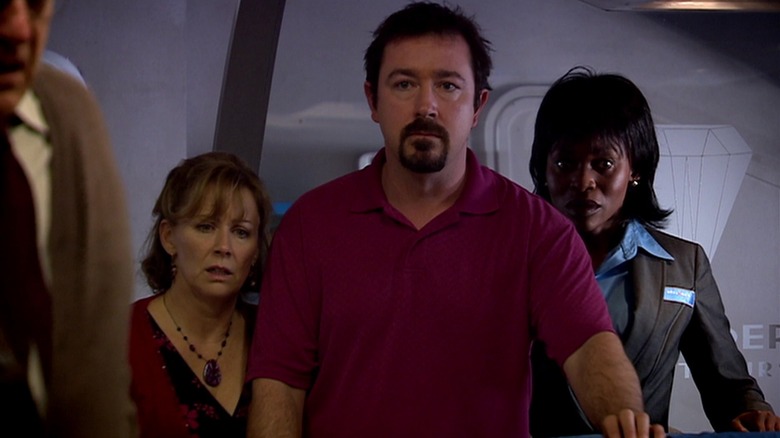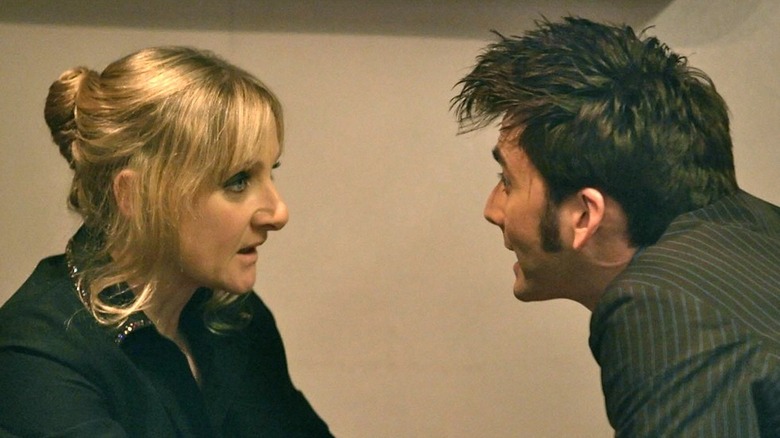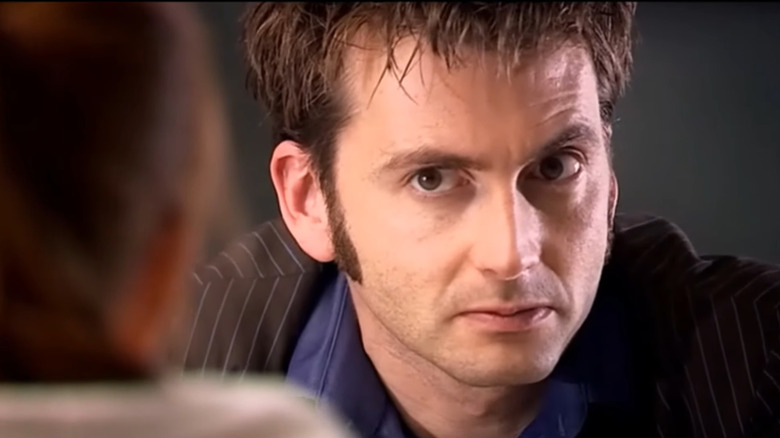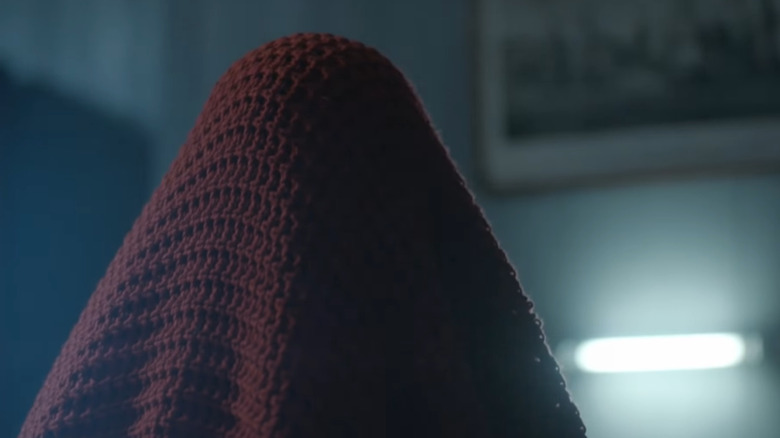How One Of Doctor Who's Cheapest Episodes Became One Of Its Best
When looking at the original breakdown for season 4 of "Doctor Who," you might be surprised to find that the famous episode "Midnight" isn't there. As explained in "The Writer's Tale," a 2008 book letting viewers in on a year's worth of emails between showrunner Russell T. Davies and journalist Benjamin Cook, the episode in its place was "Century House." It was completely different from the episode we'd get, but parts of the summary sure sound familiar:
"A double-bank episode. All Doctor. Companion-lite (she sits at home and watches the whole thing on TV with her mum; hopefully, one day's filming with her). The Doctor goes live on reality TV show 'Most Haunted' to track down the ghost of the Red Widow. A big, old, abandoned, spooky house, like on a cliff top..."
While the Doctor in "Midnight" never visited a haunted house, he did indeed get the full spotlight, with Catherine Tate's Donna almost completely absent. This is part of what Davies meant by a "double-bank" episode: "Midnight" would focus on the Doctor and sideline Donna, so that the later episode "Turn Left" could focus on Donna and sideline the Doctor. The two opposite focuses would allow the show to film both episodes at once, saving itself both money and time.
This was made clear in Davies' early summary of the not-yet-titled "Turn Left," where he didn't actually have a plot ready yet. All he had was: "Double-bank. Doctor-lite. I'll try to keep this low-cost. Honestly." From the start, Davies understood that the season 4 finale was going to be a massive, explosive event with dozens of other past characters returning; in other words, it was going to be expensive, and the show would have to cut corners elsewhere in the season when it could.
Doctor Who's always been cutting corners
The idea that Russell T. Davies was looking for ways to lower production costs shouldn't come as a surprise. The classic era of "Doctor Who" was famous for its wobbling sets and aliens that were clearly just guys in costumes. Although special effects had undoubtedly improved in the 16-year gap between the classic show and the revival, it was clear from season 1's "Rose" that "Doctor Who" still had a long way to go before its VFX team had the budget to do its premises justice.
Although "Doctor Who" would get nicer looking with the big crew shift in season 5, when Steven Moffat took over as showrunner, the show was still constantly crunching the numbers behind the scenes.
This might be why certain episodes of season 6, like the "Impossible Astronaut/Day of the Moon" two-parter, almost look like something out of a big-budget Hollywood movie, whereas other episodes ("The Curse of the Black Spot," for one) look almost jarringly low-budget. Whereas the finale certainly didn't seem to be lacking for cash, the budget for "Midnight" was so small they couldn't even afford to create an alien for it.
Finding the right placement
The script for the original episode, "Century House," was written by Tom MacRae, who'd previously written the Cybermen two-parter in season 2, and would go on to write "The Girl Who Waited" in season 6. "Tom's script is good, and we could make it great, but I don't think it can ever be great enough," Davies wrote in a September 2007 email. "It's misconceived. This is entirely my fault: I don't like the concepts I gave him, and I don't like the overall tone of both 4.7 and 4.8 being comparatively light, fun episodes."
It should be noted that although "Turn Left" was always slated for the eleventh episode placement it received, "Century House" was originally scheduled for episode 8, right after the fun, goofy Agatha Christie episode, which Davies referred to as just 4.7 throughout a lot of its development. So with "Midnight" being a much darker episode than "Century House" was supposed to be, why was it pushed back anyway?
It came down to the concerns over plot repetition: in the original episode order, Donna would've gone from "Forest of the Dead," where she'd have a whole storyline about being trapped in a fake world, followed by "Turn Left," where she'd be trapped in a parallel world. Davies was told by producer Phil Collinson that they couldn't run both episodes back-to-back, due to their similarities.
"Yikes!" Davies wrote in a 2007 update. "He's right, of course ... Hand on heart, though, I think the new order is good." He was a little concerned that the two low-budget episodes being right next to each other would cause troubles, but reminded himself that season 2's similar trick with "Fear Her" and "Love & Monsters" resulted in a ratings bump.
Writing 'Crusader 50'
In an October 2007 email, Davies gave his first summary of his basic idea for the episode:
"The Doctor goes off on a tourist trip, in a tank-like bus thing. But we don't see the outside. No models, no CGI, apart from an establisher of the planet. This, literally, takes place on one set — inside the bus — which will have to seal off its windows, so let's say there's a big old powerful X-raying sun outside. So it's a box. It's a show set in a box. That'll help our budgets right now."
With this budget-saving premise and the general idea of a creature that possesses people through their speech, Davies went to work on the script, referring to it as "Crusader 50" most of the way through, a nod to how this would be the revival's fiftieth episode. He called himself "like an idiot" for taking on the project, because thanks to the scrapping of Tom MacRae's original episode, he only had three days to finish it. "Prep on 4.8 starts on Monday, so that's a handy deadline," he wrote. "If it doesn't work...well, I can keep it as a pet project; something will happen to it one day."
He ended up sending the first forty pages to producers Phil Collinson and Julia Gardner on Sunday night, giving them the option to move forward with this script or stick to the original "Century House." He told them, "This, or Tom MacRae's! Don't make up your minds until you've read the attached. This is an odd script... But I swear it sounds right, if you just let it flow. It's all atmosphere. It depends on the tension." Sure enough — although it definitely didn't seem like a sure thing at the time — Collinson and Gardner loved it.
Lots of doubt
The script had a misleadingly high page count because of how much dialogue repetition there was, and Davies constantly worried that said repetition would end up being the episode's undoing. "You know how it drives you mad when people repeat what you say? When kids do it?" he wrote in an October 2007 email. "Imagine that not stopping. Forty minutes of it."
Although the rest of the cast and crew seemed happy with the initial read-through, Davies found it discouraging. "It just sounded slight and unimportant and weak. Maybe whacking great CUs [close ups] of fearful faces will sell it." His fears made sense: This was undoubtedly a strange, experimental episode, one that was denied not just a typical budget, but many of the usual writing flourishes people associate with Davies. Most of his episodes are filled with funny lines and goofy moments, and this one was completely serious. Most notably, he'd never written an episode that didn't have an on-screen alien before. "I don't think we've the money for a monster," he admitted early on in the writing process, "so it's sort of psychological terror."
The lack of a visible monster may have contributed to the difficulty he had with coming up with an ending, which took him several more days to finish. The conclusion he went with was uniquely upsetting: the monster's origins are never unveiled, and we never find out exactly what it wanted. The only success is that the overlooked stewardess manages to get it outside the ship where it can't hurt them — sacrificing herself along with it — leaving the Doctor and the other passengers to think about how poorly they handled everything.
Working with a tiny set
"It's a small set," said Daniel Ryan, who played an antagonistic passenger Biff Cane, for the behind-the-scenes "Doctor Who Confidential" series. "It's even smaller when it's full of a crew. And that all helps to feel hemmed in. You know, there actually is the feeling of a lack of oxygen and a lack of space and nowhere to go." Although the cast was not literally trapped in a space bus with no place to escape to, that sense of claustrophobia the characters were feeling barely need to be acted. It also helps that for most of the cast, this was the only set they were in for the entirety of filming.
Although the set was small, it was nothing like that famous moving hallway set in "Inception" a few years later, so when it came to the turbulence scene where the ship was shaking about, the crew had to get creative. "We use what's called a Dutch Head," explained cameraman Julian Barber. "It not just pans or tilts the camera; it actually turns it over on its side... I'm tilting the opposite way to their running, backwards and forwards across the set. In other words, if I tilt to the right, the actors will stagger over to the left. It gives the impression that the whole set is on the move." It wasn't as cool a solution as shaking the set for real, which Barber said would've been "lovely," but it got the job done.
The challenge of syncing up dialogue
Another big obstacle was for the actors to get the dialogue right, particularly for Leslie Sharp as the possessed Sky. At first, she's just repeating people's lines, which can be difficult to pull off when multiple people are talking at the same time. "There's no room for error, because you have to say exactly what someone else is saying," Sharp explained. "You can't make any slip-ups. Put a 'the' in at the top of a line, or an 'and' where it shouldn't be... It has to be absolutely precise."
But soon Sky starts talking simultaneously with the other characters, which is a million times harder. The timing had to be perfect. "The most difficult sequences to shoot were the ones where I had to be absolutely in sync with David," said Sharp. They rehearsed the scene "again and again and again," long before the camera was turned on.
Maybe the most difficult moment of all was when the Doctor, testing the possessed Sky's repeating skills, quickly recited the square root of Pi to its thirtieth decimal. Getting one actor to memorize all those numbers is hard enough; getting both of them to memorize it, and say it at the exact same time in the exact same manner, sounds like an almost impossible task. But as the released episode makes clear, they somehow pulled it off.
An all-time great
Even though Davies wasn't thrilled about the initial read-through, he admitted at the time that everyone else seemed to love it, and the actors were great. "Lesley synced so well with everyone — it was an astonishing performance — so it sounded interesting rather than scary. It even started to sound natural. I do worry that a thin conceit has become a whole episode. I know that I've taken a big risk. I'm a bit worried."
In the end, it was one of the best-received stories in the entire show, precisely because of how risky it is, and how different it feels from pretty much every other episode. The fact that there is no happy ending, that the episode leaves us with the Doctor shaken and disappointed in humanity, is what keeps it in your mind for days afterward. "Doctor Who" has gotten spooky plenty of times before, but "Midnight" messes with you on a deeper, gut level. "It's quite a grown up script," David Tennant said about the episode. "It's scary in quite an adult way."
Likewise, the lack of information we get about the monster turned out to be the smartest choice the show could've made. The fact that there are still things in this world not even the Doctor understands is something the show played around with constantly, but never as effectively as it does here. Everything about this episode, from the tiny closed-off set to the lack of any serious special effects, only served to heighten the strengths of Davies' script.
A notable Doctor Who trend
In a way, "Midnight" was kind of a spiritual sequel to the previous season's "Blink," another episode where the thing that saved the show money linked up perfectly with what was most dramatically effective. It would've been expensive to show what the Weeping Angels would look like when they moved, but luckily it was far scarier to leave that to the imagination.
Going forward, we'd see echoes of the blatant low-budget approach of "Midnight" in beloved episodes like "Vincent and the Doctor," which decided to make its monster-of-the-week invisible for long stretches of the story. Season 8's "Listen" went even further in this regard, giving us an episode where the monster wasn't just unseen; we're still not even sure if it exists at all. That episode's scariest moment involves a child (?) hiding under a blanket, which turned out to be far more effective horror than the usual spooky aliens "Doctor Who" throws at us.
These episodes show that "Doctor Who" is often at its best when it's embracing its low-budget roots. The show might get made fun of a lot for its relative cheapness, and nobody's ever complained about the visual improvements over the years, but "Midnight" made it clear that those money constraints weren't always a bad thing. Davies had a million things running against him while writing this story, and he ended up making one of the best episodes of his entire career.
